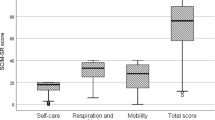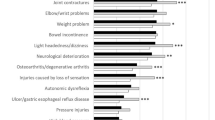Abstract
Study design:
Retrospective cohort.
Objectives:
To estimate the association between the Functional Independence Measure (FIM) for spinal cord injury (SCI) patients at time of discharge from rehabilitation and long-term resource utilization, residential status and employment. The intention was to assess the value of FIM for projecting economic burden in SCI.
Setting:
Federally designated spinal cord injury model system facilities throughout the USA.
Methods:
We analyzed data from the National Spinal Cord Injury Statistical Center database (n=14 620) (1988–2010), excluding subjects with: age <6 years, normal motor function, death before discharge or etiology from gunshot or penetrating wound (n=11685 retained). We investigated the association between motor FIM at rehabilitation discharge and residential status, survival and outcomes at 1, 5, 10, 15 and 20 years follow-up, including FIM, residential status, hospitalizations, days hospitalized in previous year, daily paid and total care and paid hours worked. Regression controlled for injury completeness, neurological level, demographic characteristics and temporal effects.
Results:
All outcomes were statistically associated with higher FIM scores at discharge. Each one-point increment in FIM was associated with improvements in: probability of institution care at discharge (−0.34%) and at follow-up (−0.13%), FIM score at follow-up (0.76 points), hospitalizations and days hospitalized/year (−0.0044 and −0.071, respectively), probability of needing paid assistance (−0.72%) or any assistance (−0.85%) and probability of paid work (0.41%).
Conclusion:
The FIM at discharge has predictive value for long-term outcomes. Improvement in FIM suggests reduced economic burden in SCI patients.
Sponsorship:
Novartis Pharmaceuticals Corporation.
Similar content being viewed by others
Log in or create a free account to read this content
Gain free access to this article, as well as selected content from this journal and more on nature.com
or
References
Kirshblum S . Rehabilitation of spinal cord injury. In: DeLisa J, Gans B, Walsh N, Bockenek W, Pease W, Frontera W et al. (eds). Physical Medicine and Rehabilitation: Principles and Practice 4th edn, Vol. 2. Lippincott Williams & Wilkins: Philadelphia, PA, 2005 pp 1715–1752.
Anonymous. Guidelines for management of acute cervical spinal injuries. Introduction. Neurosurgery 2002; 50 (3 Suppl): S1.
Anonymous. Annual Report for the Model Spinal Cord Injury Care Systems.. National Spinal Cord Injury Statistical Center: Birmingham, AL. 2007.
Cao Y, Chen Y, DeVivo M . Lifetime direct costs after spinal cord injury. Top Spinal Cord Inj Rehabil 2011; 16: 10–16.
Standard Neurological Classification of Spinal Cord Injury, American Spinal Injury Association 2006 March 1 (cited 8 February 2010); Available from: URL: http://www.asia-spinalinjury.org/publications/2006_Classif_worksheet.pdf.
Bracken MB, Shepard MJ, Collins WF, Holford TR, Young W, Baskin D et al. A randomized, controlled trial of methylprednisolone or naloxone in the treatment of acute spinal-cord injury. Results of the Second National Acute Spinal Cord Injury Study. N Engl J Med 1990; 322: 1405–1411.
Geisler FH, Coleman WP, Grieco G, Poonian D . The Sygen multicenter acute spinal cord injury study. Spine 2001; 26 (24 Suppl): S87–S98.
Anderson K, Aito S, Atkins M, Biering-Sorensen F, Charlifue S, Curt A et al. Functional recovery measures for spinal cord injury: an evidence-based review for clinical practice and research. J Spinal Cord Med 2008; 31: 133–144.
Dodds TA, Martin DP, Stolov WC, Deyo RA . A validation of the functional independence measurement and its performance among rehabilitation inpatients. Arch Phys Med Rehabil 1993; 74: 531–536.
Granger CV, Hamilton BB, Linacre JM, Heinemann AW, Wright BD . Performance profiles of the functional independence measure. Am J Phys Med Rehabil 1993; 72: 84–89.
Heinemann AW, Linacre JM, Wright BD, Hamilton BB, Granger C . Relationships between impairment and physical disability as measured by the functional independence measure. Arch Phys Med Rehabil 1993; 74: 566–573.
Linacre JM, Heinemann AW, Wright BD, Granger CV, Hamilton BB . The structure and stability of the Functional Independence Measure. Arch Phys Med Rehabil 1994; 75: 127–132.
Heinemann AW, Kirk P, Hastie BA, Semik P, Hamilton BB, Linacre JM et al. Relationships between disability measures and nursing effort during medical rehabilitation for patients with traumatic brain and spinal cord injury. Arch Phys Med Rehabil 1997; 78: 143–149.
Granger CV, Cotter AC, Hamilton BB, Fiedler RC, Hens MM . Functional assessment scales: a study of persons with multiple sclerosis. Arch Phys Med Rehabil 1990; 71: 870–875.
Heinemann AW, Linacre JM, Wright BD, Hamilton BB, Granger C . Prediction of rehabilitation outcomes with disability measures. Arch Phys Med Rehabil 1994; 75: 133–143.
Hall KM, Cohen ME, Wright J, Call M, Werner P . Characteristics of the Functional Independence Measure in traumatic spinal cord injury. Arch Phys Med Rehabil 1999; 80: 1471–1476.
Qu H, Shewchuk RM, Chen Y, Deutsch A . Impact of Medicare prospective payment system on acute rehabilitation outcomes of patients with spinal cord injury. Arch Phys Med Rehabil 2011; 92: 346–351.
De Vivo M . Discharge disposition from model spinal cord injury care system rehabilitation programs. Arch Phys Med Rehabil 1999; 80: 785–790.
DeVivo M, Krause JS, Lammertse DP . Recent trends in mortality and causes of death among persons with spinal cord injury. Arch Phys Med Rehabil 1999; 80: 1411–1419.
Eastwood EA, Hagglund KJ, Ragnarsson KT, Gordon WA, Marino RJ . Medical rehabilitation length of stay and outcomes for persons with traumatic spinal cord injury--1990-1997. Arch Phys Med Rehabil 1999; 80: 1457–1463.
Sipski ML, Jackson AB, Gomez-Marin O, Estores I, Stein A . Effects of gender on neurologic and functional recovery after spinal cord injury. Arch Phys Med Rehabil 2004; 85: 1826–1836.
De Vivo M . Sir Ludwig Guttmann Lecture: trends in spinal cord injury rehabilitation outcomes from model systems in the United States: 1973–2006. Spinal Cord 2007; 45: 713–721.
De Vivo M, Chen Y, Mennemeyer S, Deutsch A . Costs of care following spinal cord injury. Top Spinal Cord Inj Rehabil 2011; 16: 1–9.
De Vivo M, Farris V . Causes and costs of unplanned hospitalizations among persons with spinal cord injury. Top Spinal Cord Inj Rehabil 2011; 16: 53–61.
Bernaards CA, Belin TR, Schafer JL . Robustness of a multivariate normal approximation for imputation of incomplete binary data. Stat Med 2007; 26: 1368–1382.
Go B, DeVivo M, Richards J . The epidemiology of spinal cord injury. In: Stover S, DeLisa J, Whiteneck G (eds).. Spinal Cord Injury: Clinical Outcomes from the Model Systems. Aspen Publishers: Gaithersburg, MD. 1995 pp 21–55.
Catz A, Itzkovich M, Agranov E, Ring H, Tamir A . SCIM--spinal cord independence measure: a new disability scale for patients with spinal cord lesions. Spinal Cord 1997; 35: 850–856.
Catz A, Itzkovich M, Agranov E, Ring H, Tamir A . The spinal cord independence measure (SCIM): sensitivity to functional changes in subgroups of spinal cord lesion patients. Spinal Cord 2001; 39: 97–100.
Acknowledgements
This study was sponsored by Novartis Pharmaceuticals Corporation. The authors also acknowledge provision of data and technical assistance by the National Spinal Cord Injury Statistical Center (NSCISC) at the University of Alabama, the model systems that provide data to the NSCISC database, and support of the NSCISC database by the United States Department of Education (DOE), Office of Special Education and Rehabilitative Services (OSERS) and the National Institute on Disability and Rehabilitation Research (NIDRR).
Author information
Authors and Affiliations
Corresponding author
Ethics declarations
Competing interests
Drs Cohen and Terrin received grant support from Novartis Pharmaceutical Corporation. They retained control over the methodology of the study and the decision to proceed with publication. Dr Marino serves as a consultant to Novartis Pharma AG by and through the Department of Rehabilitation Medicine at Thomas Jefferson University, Philadelphia PA. Ms Sacco is employed by Novartis Pharmaceutical Corporation.
Additional information
Supplementary Information accompanies the paper on the Spinal Cord website
Supplementary information
Rights and permissions
About this article
Cite this article
Cohen, J., Marino, R., Sacco, P. et al. Association between the Functional Independence Measure following spinal cord injury and long-term outcomes. Spinal Cord 50, 728–733 (2012). https://doi.org/10.1038/sc.2012.50
Received:
Revised:
Accepted:
Published:
Issue date:
DOI: https://doi.org/10.1038/sc.2012.50
Keywords
This article is cited by
-
Rehabilitation length of stay and functional improvement among patients with traumatic spinal cord injury
Spinal Cord (2022)
-
Retrospective trends in length of stay and bowel management at discharge from inpatient rehabilitation among individuals with spinal cord injury
Spinal Cord (2022)
-
Long term outcome of functional independence and quality of life after traumatic SCI in Germany
Spinal Cord (2021)
-
A prospective examination of the impact of a supported employment program and employment on health-related quality of life, handicap, and disability among Veterans with SCI
Quality of Life Research (2013)



